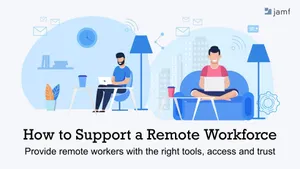We’ve all heard a lot of talk recently about how influential companies around the world are moving to embrace remote and hybrid work models, along with the frequent assumption that in the near future most office workers will be able to perform their jobs from anywhere they choose. But it’s important to recognize that there are still powerful forces working against the adoption of remote work – Tesla’s return-to-office directive and CEO Elon Musk’s comments about it provide a notable recent example.
Fighting for remote work and employee empowerment
Instead of prematurely declaring the victory of remote work, believers in its effectiveness ought to see it as something we have to fight for. And it’s equally critical to remember that simply allowing employees to work away from the office isn’t the same by a long shot as empowering them to do so.
Experience parity
Analyst firm IDC has identified “experience parity” as a consistent work experience for all employees regardless of location. It's an ongoing challenge for organizations that are moving to a hybrid model, even those that have largely solved the problem of giving remote workers the same technological tools as their in-office counterparts.
Achieving experience parity means that employees who are working remotely don’t have to deal with additional login prompts, don’t miss out on important conversations and aren’t more vulnerable to security threats compared to their in-office counterparts.
This is admittedly a difficult goal, one that often requires as much effort spent on corporate culture as it does on technological solutions. What follows is a sketch of how Jamf deals with these issues internally and how our solutions help other organizations to follow suit.
Access to resources and tools
Digital onboarding
The most obviously crucial type of parity for remote employees consists in being able to access all the organizational resources and applications that they need to perform their job duties. Traditionally, new hires at an organization go through an onboarding process that includes receiving the hardware they will use and having it configured by IT. Effective digital onboarding, complete with zero-touch deployment, gets new employees up to speed quickly by making it possible to mail them a device that is ready for work right out of the box.
Establishing digital onboarding as the norm for all new hires ensures that remote workers receive all the resources they need, and when executed correctly it can save time and increase efficiency for IT admins and in-office employees as well. And by offering a corporate “app store” like Jamf’s Self Service for distributing approved software, organizations can help employees expand and customize their digital toolkits as their jobs evolve.
Zero Trust Network Access (ZTNA)
The old perimeter security model, which focuses on putting sensitive organizational resources on a secure network that employees can access on the premises, can cause major difficulties for remote employees. Accessing the information and tools they need for work often requires installing unwieldy network hardware in the home and/or going through the extra step of logging into a virtual private network (VPN) to perform certain tasks. Adopting a Zero Trust Network Access (ZTNA) approach levels the playing field by authenticating all users and devices attempting to use any company resource.
ZTNA makes it easy to work in the office, at home or anywhere else, without compromising an organization’s security posture. And when used in conjunction with an identity and access management (IAM) solution, it’s possible to eliminate login fatigue by providing single sign-on (SSO) access to the company’s full range of applications.
Access to physical spaces
Employees may normally be all-remote but visit an office occasionally for meetings. Such employees may misplace a badge or fob that they rarely use, or they may never be issued one at all. At Jamf, we recently changed our building access systems so that employees can use their iPhones to enter our offices. Little touches like that can streamline office visits and allow organizations to get the most out of their employees’ time. It’s just another way to ensure that all workers enjoy the same levels of access regardless of where they work from.
Communication practices
It can be alienating to work remotely when most of your coworkers see each other in the office. You may find yourself excluded from impromptu meetings and break-room chats, and it can be difficult to get a read on your teammates’ emotions or to casually ask for clarification without starting formal conversations. Committing to a digital-first model for team communications helps – just because some of you might be in the same place doesn’t mean you can’t connect via teleconferencing or online chat.
Establish communications principles
But communicating digitally comes with its own challenges. It’s hard to convey tone via textual exchanges, and team members may differ in which channels they prefer and what their expectations are for response time. Following Erica Dhawan’s work on “digital body language,” Jamf has published principles for communications between team members. With explicit guidelines for tone, medium and frequency, it becomes easier to bridge gaps in generational norms and individual communication styles. And all of this is geared toward a team dynamic that never sidelines remote workers.
Digital events
Team-building exercises and company social events can also take place in the digital space, and in the wake of the pandemic it is much easier to find event facilitators who can provide remote entertainment and challenges. Your team might enjoy a virtual pub trivia night or escape room challenge, or issue food delivery vouchers so everyone can enjoy a nice lunch together. When remote and in-office employees alike are used to gathering digitally, these virtual events are more likely to boost morale and forge stronger bonds.
Security and online safety
One negative effect that many organizations have encountered with remote work is an increased exposure to security risks like phishing and ransomware. As employees use their own networks and – in organizations with “Bring Your Own Device” (BYOD) programs – often rely heavily on personal mobile devices, they are exposed to more threats and often enjoy fewer protections.
Network access and endpoint protection
Good ZTNA architecture can eliminate many of the risks inherent in working from home or a shared public space, and Jamf offers powerful network access and endpoint protection solutions to guard users and devices from cyber threats. Jamf Connect provides secure connections for Mac and mobile devices, while Jamf Protect monitors and protects numerous attack vectors, giving remote employees the peace of mind that they don’t have to shoulder a higher degree of risk than in-office workers.
Identical security protections
Organizations can also provide experience parity for remote workers by ensuring that they have the same content filtering and data consumption policies in place as everyone else. Helping employees to avoid inappropriate or malicious online material and to get a fair share of network connectivity is easy with a solution like Jamf Protect.
Security is certainly one of the greatest challenges facing companies with remote employees, and no one wants to experience a data breach because of a lack of vigilance. But with same-day support for Apple updates and mobile device management (MDM) tools that can keep employee devices supervised and up to date, there is plenty IT can do to protect the private information of both the company and the employees, wherever they may work.
Building a better world for all employees
The truth is that allowing employees to work from home without proper support isn’t doing them any favors, and no organization wants a large portion of its workforce to lack the proper tools, information and protection to get the job done. But with the right technology solutions and a bit of strategic planning, managing and securing corporate devices makes it possible to fully value and empower remote employees. A world in which we don’t have to all work from the office is a world in which employment can be more flexible, equitable and dynamic. We at Jamf think that’s a world worth fighting for.
Ready to find out how Jamf can help you empower your remote workforce?
Test-drive one of our solutions today.
by Category:
Have market trends, Apple updates and Jamf news delivered directly to your inbox.
To learn more about how we collect, use, disclose, transfer, and store your information, please visit our Privacy Policy.





